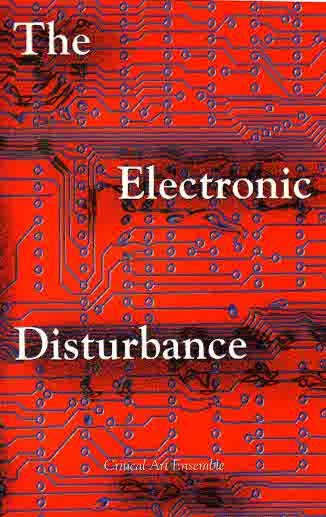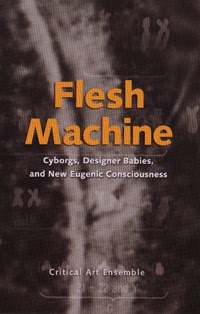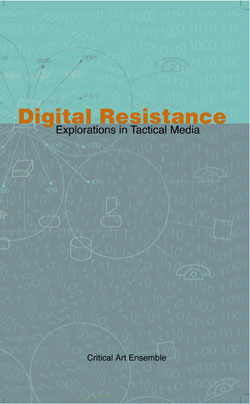Critical Art Ensemble (1994-2006)
Filed under book | Tags: · activism, art, biotechnology, control society, copyright, cultural resistance, tactical media, transgenics, virtuality

The Electronic Disturbance (1994)
The Critical Arts Ensemble is a virtual collective. This collection of essays and short pieces examines the changing rules of cultural and political resistance: “The current technological revolution has created a new geography of power relations — as data, human beings confront an authoritarial impulse that thrives on absence. As a virtual geography of cognizance and action, resistance must assert itself in electronic space.”
Publisher Autonomedia, May 1994
ISBN 1570270066

Electronic Civil Disobedience and Other Unpopular Ideas (1997)
In the age of global, nomadic capital, the CAE attempts to lay the foundation for the growth of nomadic resistance. Utilizing the tools of its enemy, the CAE suggests that a new cultural and political resistance is possible. Fusing a situationist-influenced concept of contestational art, an understanding of the parallel nature of cultural and political action borrowed from Gramsci, and a hacker’s deep understanding of how new technology functions, ECD is a launch point for debating the nature of power and resistance in the information age.
Publisher Autonomedia, May 1997
ISBN 9781570270567
commentary (Stefan Wray)
authors
publisher
PDF
View online, cont. (La Résistance électronique et autres idées impopulaires, French)

Flesh Machine: Cyborgs, Designer Babies, and New Eugenic Consciousness (1998)
Having elsewhere explored the dimensions of social and political control in electronic culture, the Critical Arts Ensemble here turns full frontal towards the body, arguing that utopian promises of virtuality are simple distractions from the real project: the deployment of biotechnologies upon the bodies of citizens in the service of the transnational order.
Publisher Autonomedia, March 1998
ISBN 9781570270673
PDF
PDF (Η μηχανή της σάρκας: Εκδόσεις των ξένων, Greek)

Digital Resistance: Explorations in Tactical Media (2000)
Essays in cultural politics and technology from the collective authors of Electronic Disturbance, Electronic Civil Disobedience and Flesh Machine. Chapters in this new volume include “Electronic Civil Disobedience and the Public Sphere,” “The Mythology of Terrorism on the Net,” “The Promissory Rhetoric of Biotechnology,” “Observations on Collective Cultural Action,” “Recombinant Theater and Digital Resistance,” “Contestational Robotics,” “Children as Tactical Media Participants,” and “The Financial Advantages of Anti-Copyright.”
Publisher Autonomedia, April 2000
ISBN 1570271194

The Molecular Invasion (2002)
Having exhausted the possibilities for geographic colonial expansion, as well as reaching the fiscal limitations of virtual space, capital begins its invasion of a new frontier — organic molecular space. The Critical Art Ensemble began mapping this development in Flesh Machine (Autonomedia, 1998) by examining the use of reproductive technologies and their promise for achieving an intensified degree of control over worker and citizen. The Molecular Invasion acts as a companion to this first book by mapping the politics of transgenics, and offering a model for the creation of a contestational biology, as well as providing direct interventionist tactics for the disruption of this new assault on the organic realm.
Publisher Autonomedia, April 2002
ISBN 1570271380, 9781570271380
140 pages
PDF
PDF (Molekularna invazija, Croatian)

Marching Plague: Germ Warfare and Global Public Health (2006)
The sixth Critical Art Ensemble book offers a radical reframing of the rhetoric surrounding germ warfare. After refuting the idea that massive biological attack is a probable future occurrence, the book goes on to argue that biological weapons programs primarily serve the economic interests of the military-security complex, squandering resources needed to fight the massive loss of life each year from emerging infectious diseases. The book also includes two appendices examining the case of the U.S. Justice Department against Steve Kurtz, for which the original manuscript of the book was seized in the state’s investigation.
Publisher Autonomedia, 2006
ISBN 157027178X, 9781570271786
148 pages
review (Randall Packer)
authors
publisher
Richard Barbrook: Imaginary Futures: From Thinking Machines to the Global Village (2007)
Filed under book | Tags: · artificial intelligence, computing, control society, cybernetics, gift economy, history of computing, history of technology, information society, internet, politics

“Cooperative creativity and participatory democracy should be extended from the virtual world into all areas of life. This time, the new stage of growth must be a new civilisation.
Richard Barbrook traces the early days of the Internet, beginning from a pivotal point at the 1964 World’s Fair, in what critics are saying is the most well-researched and original account of cybertechnology among contemporary works. He demonstrates how business and ideological leaders put forth a carefully orchestrated vision of an imaginary future, where robots would do the washing up, go to the office and think for us. With America at the forefront of these promises, Barbrook shows how ideological forces joined to develop new information technologies during the Cold War era and how what they created historically has shaped the modern Internet, with intended political consequences.
Crucially, he argues that had the past been different, our technological and political present would not be what it is today. Barbrook’s conclusions about the modern state of the Internet, puts forward a call for action in how the world’s most important tool of revolutionary politics should be approached.”
Key terms: Fordism, W.W. Rostow, Marxism, cybernetic, Bell commission, artificial intelligence, gift economy, Stalinist, Maoist, Cold War game, Trotskyist, information society, laissez-faire liberalism, soft power, Hard power, American empire, Tet Offensive, Unisphere, grand narrative, Cold War Left
Publisher Pluto, 2007
ISBN 0745326609, 9780745326603
334 pages
Book website
Video introduction
Publisher
PDF, PDF (13 MB, updated on 2012-7-15)
Comments (3)EFF: Surveillance Self-Defense (2009)
Filed under manual | Tags: · control society, law, surveillance

The Electronic Frontier Foundation (EFF) has created this Surveillance Self-Defense site to educate the American public about the law and technology of government surveillance in the United States, providing the information and tools necessary to evaluate the threat of surveillance and take appropriate steps to defend against it.
Surveillance Self-Defense (SSD) exists to answer two main questions: What can the government legally do to spy on your computer data and communications? And what can you legally do to protect yourself against such spying?
After an introductory discussion of how you should think about making security decisions — it’s all about risk management — we’ll be answering those two questions for three types of data:
First, we’re going to talk about the threat to the data stored on your computer posed by searches and seizures by law enforcement, as well as subpoenas demanding your records.
Second, we’re going to talk about the threat to your data on the wire — that is, your data as it’s being transmitted — posed by wiretapping and other real-time surveillance of your telephone and Internet communications by law enforcement.
Third, we’re going to describe the information about you that is stored by third parties like your phone company and your Internet service provider, and how law enforcement officials can get it.
In each of these three sections, we’re going to give you practical advice about how to protect your private data against law enforcement agents.
In a fourth section, we’ll also provide some basic information about the U.S. government’s expanded legal authority when it comes to foreign intelligence and terrorism investigations.
Finally, we’ve collected several articles about specific defensive technologies that you can use to protect your privacy, which are linked to from the other sections or can be accessed individually. So, for example, if you’re only looking for information about how to securely delete your files, or how to use encryption to protect the privacy of your emails or instant messages, you can just directly visit that article.
PDF (Printer-friendly HTML)
Comment (0)
